engine Citroen DS4 RHD 2013.5 1.G Service Manual
[x] Cancel search | Manufacturer: CITROEN, Model Year: 2013.5, Model line: DS4 RHD, Model: Citroen DS4 RHD 2013.5 1.GPages: 400, PDF Size: 31.86 MB
Page 122 of 400
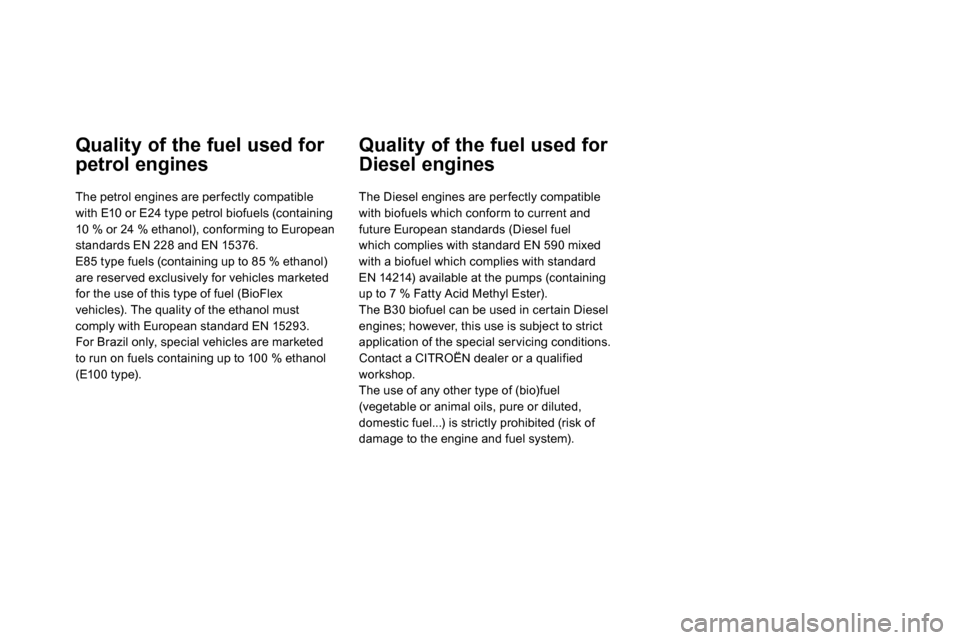
Quality of the fuel used for
petrol engines
The petrol engines are per fectly compatible
with E10 or E24 type petrol biofuels (containing
10 % or 24 % ethanol), conforming to European
standards EN 228 and EN 15376.
E85 type fuels (containing up to 85 % ethanol)
are reserved exclusively for vehicles marketed
for the use of this type of fuel (BioFlex
vehicles). The quality of the ethanol must
comply with European standard EN 15293.
For Brazil only, special vehicles are marketed
to run on fuels containing up to 100 % ethanol
(E100 type).
Quality of the fuel used for
Diesel engines
The Diesel engines are per fectly compatible
with biofuels which conform to current and
future European standards (Diesel fuel
which complies with standard EN 590 mixed
with a biofuel which complies with standard
EN 14214) available at the pumps (containing
up to 7 % Fatty Acid Methyl Ester).
The B30 biofuel can be used in certain Diesel
engines; however, this use is subject to strict
application of the special ser vicing conditions.
Contact a CITROËN dealer or a qualified
workshop.
The use of any other type of (bio)fuel
(vegetable or animal oils, pure or diluted,
domestic fuel...) is strictly prohibited (risk of
damage to the engine and fuel system).
Page 123 of 400
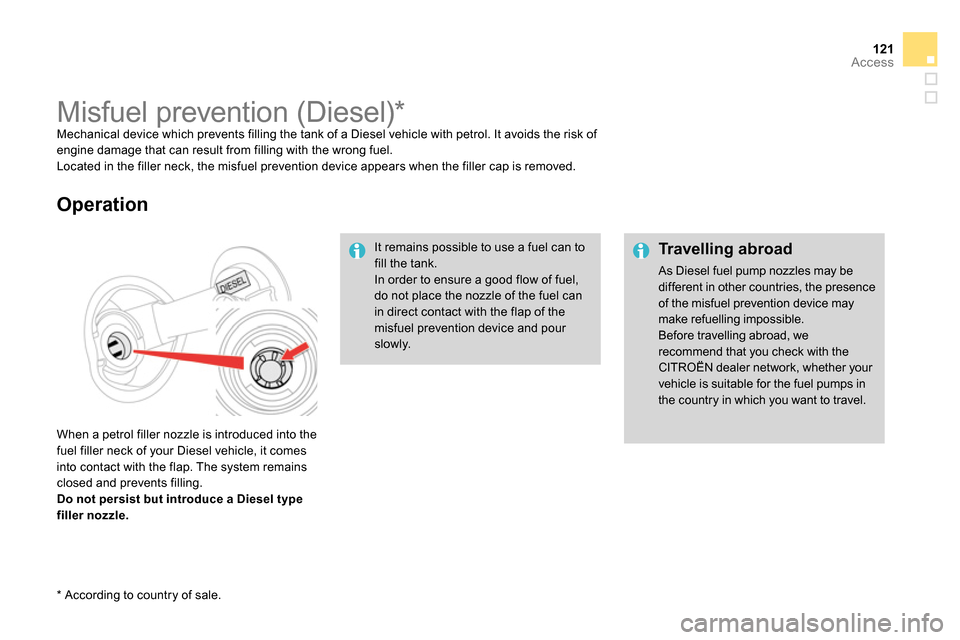
121Access
Travelling abroad
As Diesel fuel pump nozzles may be
different in other countries, the presence
of the misfuel prevention device may
make refuelling impossible.
Before travelling abroad, we
recommend that you check with the
CITROËN dealer network, whether your
vehicle is suitable for the fuel pumps in
the country in which you want to travel.
Misfuel prevention (Diesel) *
Mechanical device which prevents filling the tank of a Diesel vehicle with petrol. It avoids the risk of
engine damage that can result from filling with the wrong fuel.
Located in the filler neck, the misfuel prevention device appears when the filler cap is removed.
When a petrol filler nozzle is introduced into the
fuel filler neck of your Diesel vehicle, it comes
into contact with the flap. The system remains
closed and prevents filling.
Do not persist but introduce a Diesel type
filler nozzle.
Operation
It remains possible to use a fuel can to
fill the tank.
In order to ensure a good flow of fuel,
do not place the nozzle of the fuel can
in direct contact with the flap of the
misfuel prevention device and pour
slowly.
*
According to country of sale.
Page 127 of 400
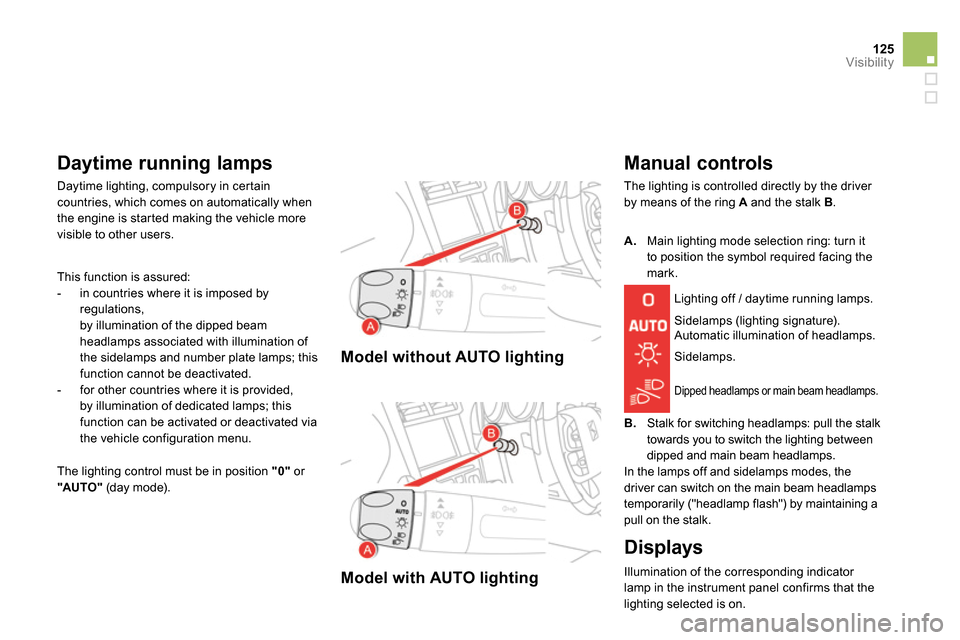
125Visibility
Model without AUTO lighting
Model with AUTO lighting
Manual controls
The lighting is controlled directly by the driver
by means of the ring A
and the stalk B
.
Sidelamps (lighting signature).
Automatic illumination of headlamps.
B.
Stalk for switching headlamps: pull the stalk
towards you to switch the lighting between
dipped and main beam headlamps.
In the lamps off and sidelamps modes, the
driver can switch on the main beam headlamps
temporarily ("headlamp flash") by maintaining a
pull on the stalk.
A.
Main lighting mode selection ring: turn it
to position the symbol required facing the
mark.
Lighting off / daytime running lamps.
Sidelamps.
Dipped headlamps or main beam headlamps.
Displays
Illumination of the corresponding indicator
lamp in the instrument panel confirms that the
lighting selected is on. Daytime lighting, compulsory in certain
countries, which comes on automatically when
the engine is started making the vehicle more
visible to other users.
This function is assured:
- in countries where it is imposed by
regulations,
by illumination of the dipped beam
headlamps associated with illumination of
the sidelamps and number plate lamps; this
function cannot be deactivated.
- for other countries where it is provided,
by illumination of dedicated lamps; this
function can be activated or deactivated via
the vehicle configuration menu.
Daytime running lamps
The lighting control must be in position "0"
or
"AUTO "
(day mode).
Page 137 of 400
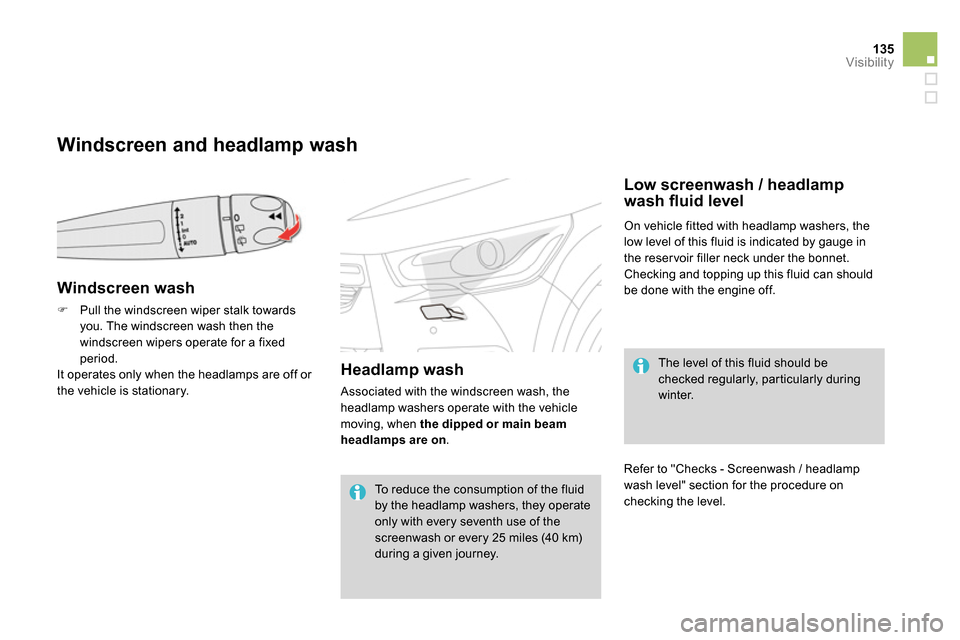
135Visibility
Windscreen and headlamp wash
Windscreen wash
Pull the windscreen wiper stalk towards
you. The windscreen wash then the
windscreen wipers operate for a fixed
period.
It operates only when the headlamps are off or
the vehicle is stationary.
Low screenwash / headlamp
wash fl uid level
On vehicle fitted with headlamp washers, the
low level of this fluid is indicated by gauge in
the reservoir filler neck under the bonnet.
Checking and topping up this fluid can should
be done with the engine off.
The level of this fluid should be
checked regularly, particularly during
winter.
Refer to "Checks - Screenwash / headlamp
wash level" section for the procedure on
checking the level.
Headlamp wash
Associated with the windscreen wash, the
headlamp washers operate with the vehicle
moving, when the dipped or main beam
headlamps are on
.
To reduce the consumption of the fluid
by the headlamp washers, they operate
only with every seventh use of the
screenwash or every 25 miles (40 km)
during a given journey.
Page 140 of 400
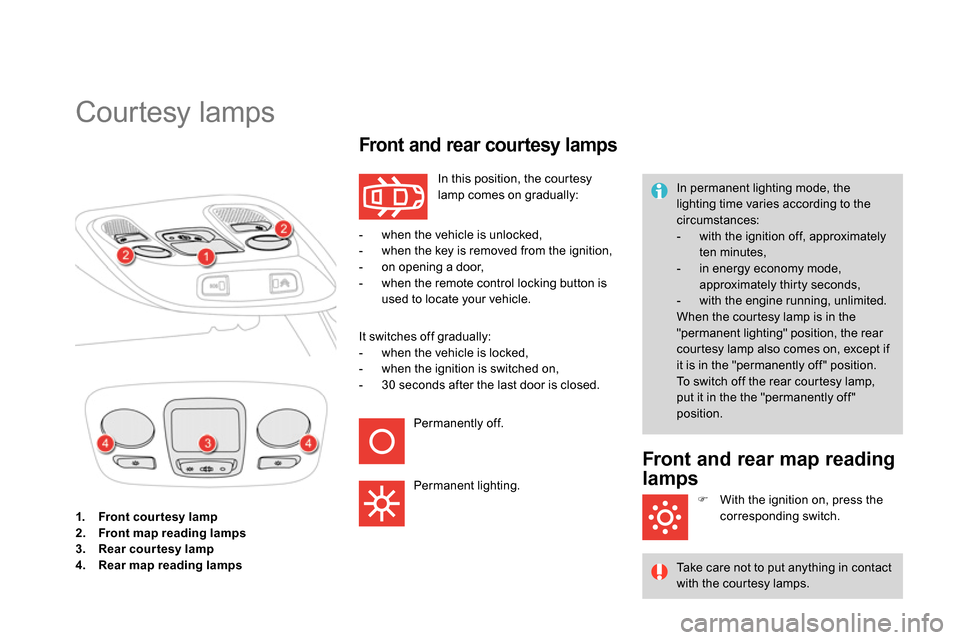
1.
Front cour tesy lamp
2.
Front map reading lamps
3.
Rear courtesy lamp
4.
Rear map reading lamps
Courtesy lamps
In this position, the courtesy
lamp comes on gradually:
Front and rear courtesy lamps
- when the vehicle is unlocked,
- when the key is removed from the ignition,
- on opening a door,
- when the remote control locking button is
used to locate your vehicle.
It switches off gradually:
- when the vehicle is locked,
- when the ignition is switched on,
- 30 seconds after the last door is closed.
Permanently off.
Permanent lighting. In permanent lighting mode, the
lighting time varies according to the
circumstances:
- with the ignition off, approximately
ten minutes,
- in energy economy mode,
approximately thir ty seconds,
- with the engine running, unlimited.
When the courtesy lamp is in the
"permanent lighting" position, the rear
courtesy lamp also comes on, except if
it is in the "permanently off " position.
To switch off the rear courtesy lamp,
put it in the the "permanently off "
position.
Front and rear map reading
lamps
With the ignition on, press the
corresponding switch.
Take care not to put anything in contact
with the courtesy lamps.
Page 142 of 400
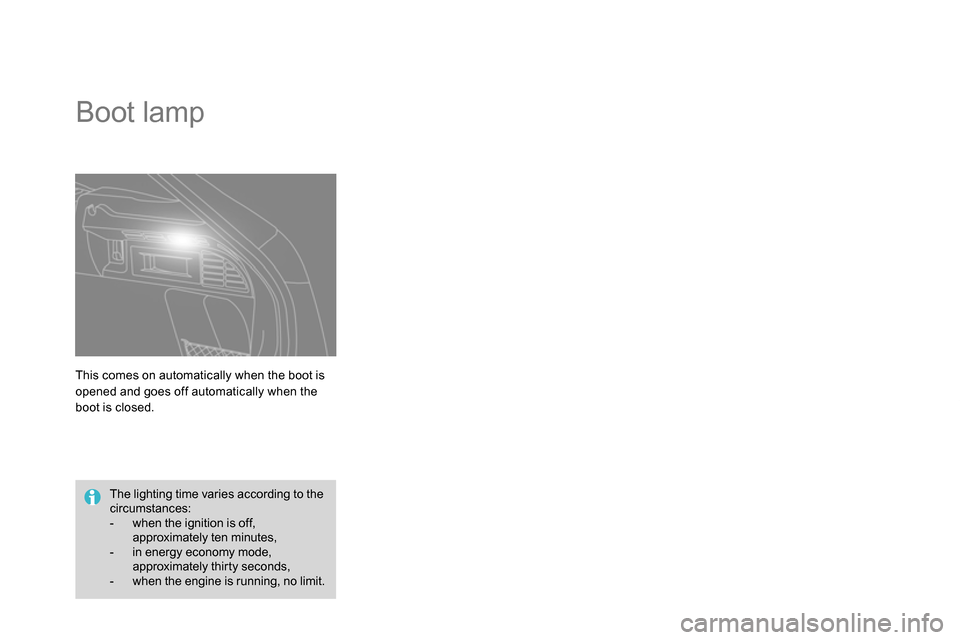
This comes on automatically when the boot is
opened and goes off automatically when the
boot is closed.
Boot lamp
The lighting time varies according to the
circumstances:
- when the ignition is off,
approximately ten minutes,
- in energy economy mode,
approximately thir ty seconds,
- when the engine is running, no limit.
Page 181 of 400
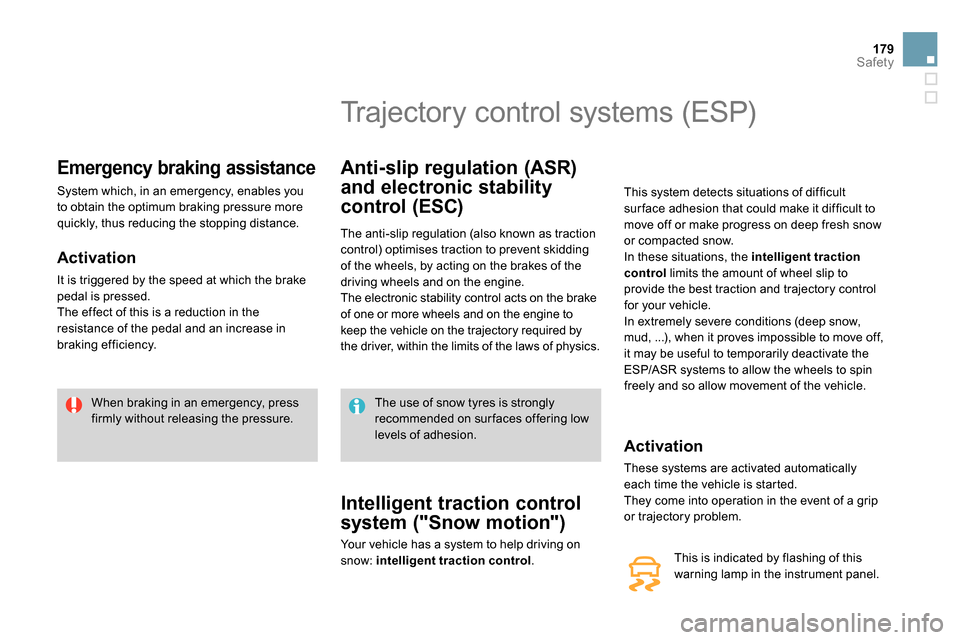
179Safety
Emergency braking assistance
System which, in an emergency, enables you
to obtain the optimum braking pressure more
quickly, thus reducing the stopping distance.
Activation
It is triggered by the speed at which the brake
pedal is pressed.
The effect of this is a reduction in the
resistance of the pedal and an increase in
braking efficiency.
When braking in an emergency, press
firmly without releasing the pressure.
Trajectory control systems (ESP)
Anti-slip regulation (ASR)
and electronic stability
control (ESC)
The anti-slip regulation (also known as traction
control) optimises traction to prevent skidding
of the wheels, by acting on the brakes of the
driving wheels and on the engine.
The electronic stability control acts on the brake
of one or more wheels and on the engine to
keep the vehicle on the trajectory required by
the driver, within the limits of the laws of physics.
Activation
These systems are activated automatically
each time the vehicle is started.
They come into operation in the event of a grip
or trajectory problem.
This is indicated by flashing of this
warning lamp in the instrument panel.
Intelligent traction control
system ("Snow motion")
Your vehicle has a system to help driving on
snow: intelligent traction control.
The use of snow tyres is strongly
recommended on sur faces offering low
levels of adhesion.
This system detects situations of difficult
sur face adhesion that could make it difficult to
move off or make progress on deep fresh snow
or compacted snow.
In these situations, the intelligent traction
control
limits the amount of wheel slip to
provide the best traction and trajectory control
for your vehicle.
In extremely severe conditions (deep snow,
mud, ...), when it proves impossible to move off,
it may be useful to temporarily deactivate the
ESP/ASR systems to allow the wheels to spin
freely and so allow movement of the vehicle.
Page 185 of 400
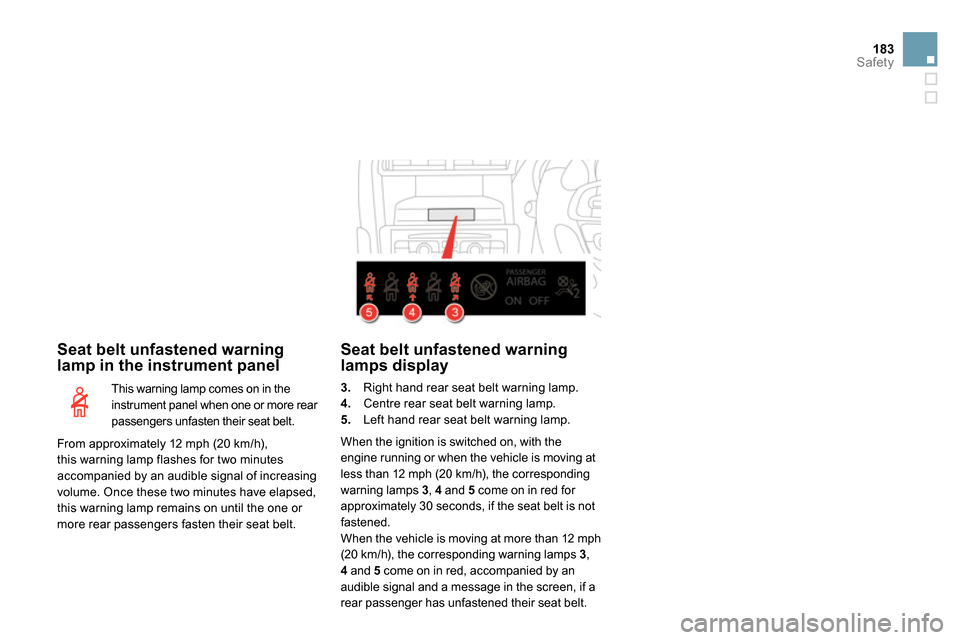
183Safety
Seat belt unfastened warning
lamp in the instrument panel
This warning lamp comes on in the
instrument panel when one or more rear
passengers unfasten their seat belt.
Seat belt unfastened warning
lamps display
3.
Right hand rear seat belt warning lamp.
4.
Centre rear seat belt warning lamp.
5.
Left hand rear seat belt warning lamp.
When the ignition is switched on, with the
engine running or when the vehicle is moving at
less than 12 mph (20 km/h), the corresponding
warning lamps 3
, 4
and 5
come on in red for
approximately 30 seconds, if the seat belt is not
fastened.
When the vehicle is moving at more than 12 mph
(20 km/h), the corresponding warning lamps 3
,
4
and 5
come on in red, accompanied by an
audible signal and a message in the screen, if a
rear passenger has unfastened their seat belt.
From approximately 12 mph (20 km/h),
this warning lamp flashes for two minutes
accompanied by an audible signal of increasing
volume. Once these two minutes have elapsed,
this warning lamp remains on until the one or
more rear passengers fasten their seat belt.
Page 196 of 400
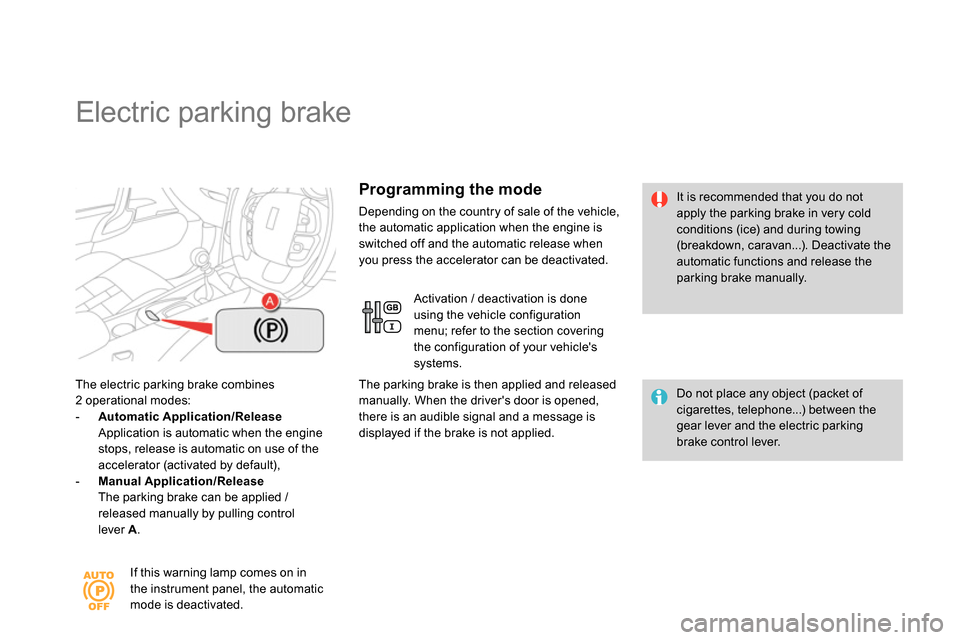
Electric parking brake
The electric parking brake combines
2 operational modes:
- Automatic Application/Release
Application is automatic when the engine
stops, release is automatic on use of the
accelerator (activated by default),
- Manual Application/Release
The parking brake can be applied /
released manually by pulling control
lever A
.
Do not place any object (packet of
cigarettes, telephone...) between the
gear lever and the electric parking
brake control lever.
It is recommended that you do not
apply the parking brake in very cold
conditions (ice) and during towing
(breakdown, caravan...). Deactivate the
automatic functions and release the
parking brake manually.
If this warning lamp comes on in
the instrument panel, the automatic
mode is deactivated.
Programming the mode
Depending on the country of sale of the vehicle,
the automatic application when the engine is
switched off and the automatic release when
you press the accelerator can be deactivated.
Activation / deactivation is done
using the vehicle configuration
menu; refer to the section covering
the configuration of your vehicle's
systems.
The parking brake is then applied and released
manually. When the driver's door is opened,
there is an audible signal and a message is
displayed if the brake is not applied.
Page 197 of 400
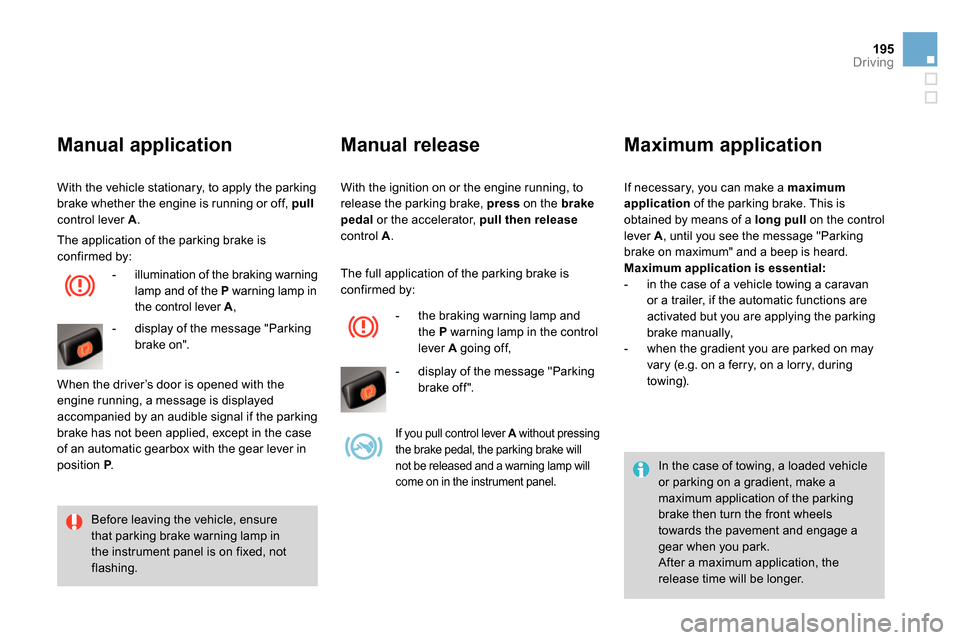
195Driving
With the ignition on or the engine running, to
release the parking brake, press
on the brake
pedal
or the accelerator, pull then release
control A
.
Manual release
Before leaving the vehicle, ensure
that parking brake warning lamp in
the instrument panel is on fixed, not
flashing.
Manual application
With the vehicle stationary, to apply the parking
brake whether the engine is running or off, pull
control lever A
.
The application of the parking brake is
confirmed by:
- illumination of the braking warning
lamp and of the P
warning lamp in
the control lever A
,
- display of the message "Parking
brake on".
When the driver’s door is opened with the
engine running, a message is displayed
accompanied by an audible signal if the parking
brake has not been applied, except in the case
of an automatic gearbox with the gear lever in
position P
. The full application of the parking brake is
confirmed by:
- the braking warning lamp and
the P
warning lamp in the control
lever A
going off,
- display of the message "Parking
brake off ".
If you pull control lever A
without pressing
the brake pedal, the parking brake will
not be released and a warning lamp will
come on in the instrument panel.
Maximum application
If necessary, you can make a maximum
application
of the parking brake. This is
obtained by means of a long pull
on the control
lever A
, until you see the message "Parking
brake on maximum" and a beep is heard.
Maximum application is essential:
- in the case of a vehicle towing a caravan
or a trailer, if the automatic functions are
activated but you are applying the parking
brake manually,
- when the gradient you are parked on may
vary (e.g. on a ferry, on a lorry, during
towing).
In the case of towing, a loaded vehicle
or parking on a gradient, make a
maximum application of the parking
brake then turn the front wheels
towards the pavement and engage a
gear when you park.
After a maximum application, the
release time will be longer.